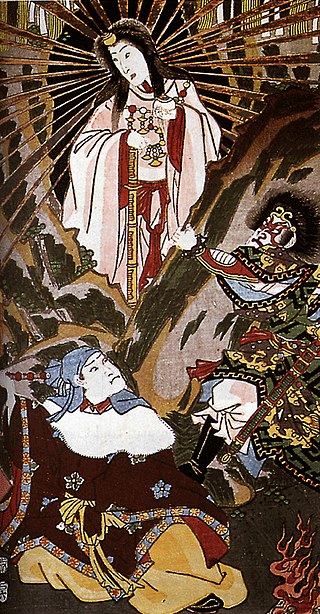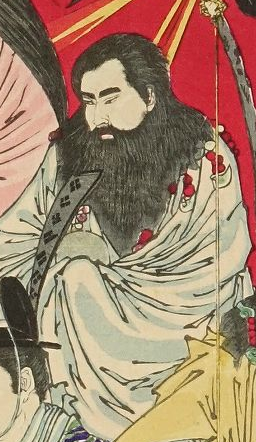In Shinto, Kotoamatsukami is the collective name for the first gods which came into existence at the time of the creation of the universe. They were born in Takamagahara, the world of Heaven at the time of the creation. Unlike the later gods, these deities were born without any procreation.

Amaterasu, also known as Amaterasu Ōmikami or Ōhirume no Muchi no Kami (大日孁貴神), is the goddess of the sun in Japanese mythology. Often considered the chief deity (kami) of the Shinto pantheon, she is also portrayed in Japan's earliest literary texts, the Kojiki and the Nihon Shoki, as the ruler of the heavenly realm Takamagahara and the mythical ancestress of the Imperial House of Japan via her grandson Ninigi. Along with her siblings, the moon deity Tsukuyomi and the impetuous storm god Susanoo, she is considered to be one of the "Three Precious Children", the three most important offspring of the creator god Izanagi.
Susanoo, often referred to by the honorific title Susanoo-no-Mikoto, is a kami in Japanese mythology. The younger brother of Amaterasu, goddess of the sun and mythical ancestress of the Japanese imperial line, he is a multifaceted deity with contradictory characteristics, being portrayed in various stories either as a wild, impetuous god associated with the sea and storms, as a heroic figure who killed a monstrous serpent, or as a local deity linked with the harvest and agriculture. Syncretic beliefs of the Gion cult that arose after the introduction of Buddhism to Japan also saw Susanoo becoming conflated with deities of pestilence and disease.

Ōyama-tsumi or Ohoyama-tsumi, also Ōyama-tsumi-mi'oya-no-mikoto (大山祇御祖命), is a god of mountains, sea, and war in Japanese mythology. He is an elder brother of Amaterasu and Susanoo. His other names are Watashi-no-Ōkami (和多志大神) and Sakatoke (酒解神).

Ninigi-no-Mikoto is a deity in Japanese mythology. Grandson of the sun goddess Amaterasu, Ninigi is regarded according to Japanese mythology as the great-grandfather of Japan’s first emperor, Emperor Jimmu. The three sacred treasures brought with Ninigi from Heaven and divine ancestry established the Japanese Imperial Family.

Ōkuninushi, also known as Ō(a)namuchi or Ō(a)namochi among other variants, is a kami in Japanese mythology and the god of the underworld. He is one of the central deities in the cycle of myths recorded in the Kojiki and the Nihon Shoki alongside the sun goddess Amaterasu and her brother, the wild god Susanoo, who is reckoned to be either Ōkuninushi's distant ancestor or father. In these texts, Ōkuninushi (Ōnamuchi) is portrayed as the head of the kunitsukami, the gods of the earth, and the original ruler of the terrestrial world, named Ashihara no Nakatsukuni. When the heavenly deities (amatsukami) headed by Amaterasu demanded that he relinquish his rule over the land, Ōkuninushi agreed to their terms and withdrew into the unseen world, which was given to him to rule over in exchange. Amaterasu's grandson Ninigi then came down from heaven to govern Ashihara no Nakatsukuni and eventually became the ancestor of the Japanese imperial line.

Futsunushi, also known as Iwainushi, is a warrior god in Japanese mythology. Also known under the epithet Katori Daimyōjin (香取大明神) after his shrine in northern Chiba Prefecture, Katori Jingū, he is often revered alongside Takemikazuchi, with whom he is closely associated. He is regarded as a legendary ancestor of the Mononobe clan, and like Takemikazuchi is one of the tutelary deities of the Fujiwara clan.

In Shinto faith, Kuninotokotachi(国之常立神, Kuninotokotachi-no-Kami, in Kojiki)(国常立尊, Kuninotokotachi-no-Mikoto, in Nihonshoki or Kuni-toko-tachi is one of the two gods born from "something like a reed that arose from the soil" when the Earth was chaotic. In the Kojiki, he is the first of the seven generations of divinities born after the first five divinities were born at the time of the creation of the Universe. In the Nihon Shoki, he is the first of the three divinities born after Heaven and Earth were born out of chaos, and is born from something looking like a reed-shoot growing between heaven and earth. He is known by mythology to reside on top of Mount Fuji.

Ukanomitama is a kami in classical Japanese mythology, associated with food and agriculture, often identified with Inari, the deity of rice.
Ame-no-Minakanushi is a deity (kami) in Japanese mythology, portrayed in the Kojiki and the Nihon Shoki as the very first or one of the first deities who manifested when heaven and earth came into existence.
In Japanese mythology, the Kamiyo-nanayo are the seven generations of kami that emerged after the formation of heaven and earth.
In Japanese mythology, the Japanese Creation Myth is the story that describes the legendary birth of the celestial and creative world, the birth of the first gods, and the birth of the Japanese archipelago.
The kuni-yuzuri (国譲り) "Transfer of the land" was a mythological event in Japanese prehistory, related in sources such as the Kojiki and the Nihon Shoki. It relates the story of how the rulership of Japan passed from the earthly kami (kunitsukami) to the kami of Heaven (amatsukami) and their eventual descendants, the Imperial House of Japan.

Amenooshihomimi (天忍穗耳尊,天之忍穂耳命) or Oshihomimi for short, is the first son of Amaterasu.
Takamimusubi is a god of agriculture in Japanese mythology, who was the second of the first beings to come into existence.
Kamimusubi (神産巣日), also known as Kamimusuhi among other variants, is a kami and god of creation in Japanese mythology. They are a hitorigami, and the third of the first three kami to come into existence (Kotoamatsukami), alongside Ame-no-Minakanushi and Takamimusubi, forming a trio at the beginning of all creation. The name is composed of kami, denoting deity, and musubi, meaning "effecting force of creation".
Tamakushi-hime also known as Mishimanomizokui-hime and Seyadatarahime (セヤダタラヒメ), is a feminine deity who appears in Japanese mythology. She is known as the mother of Himetataraisuzu-hime, the first empress of Japan, Kamo no Okimi, a distant ancestor of the Miwa clan, Kamigamo the deity of Kamigamo Shrine. She is also known as Princess Mishima-Mizo, Seiyadatarahihime, Katsutamayori-biyorihime and Kimikahihime.

Oyamakui no Kami (大山咋神) is a Japanese god highly significant in Sannō Ichijitsu Shintō, and worshipped in the Hiyoshi Taisha network of shrines and the Matsunoo Taisha network. They are also known as Sanno Gongen in a Buddhist context. They are the son of Toshigami and grandson of Susanoo. Oyamakui no Kami is considered to be androgynous and possibly hermaphroditic. They are the kami of mountains and good health.
Yashimajinumi (八島士奴美神) was a Japanese god.









